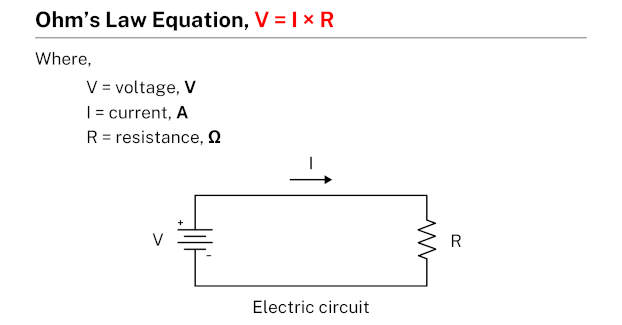
Ohm’s law describes the relationship between voltage, current, and resistance in an electrical circuit. It states that the current passing through a conductor between two points is directly proportional to the voltage across the two points and inversely proportional to the resistance of the conductor. This principle is essential for understanding how electrical circuits function and for designing and troubleshooting electrical and electronic devices. By using Ohm’s law, engineers and scientists can predict how different components will behave under various voltage and resistance conditions, ensuring the proper operation of circuits.
Ohm’s law is mathematically expressed as:
$$V = IR$$where V represents the voltage in volts, I denotes the current in amperes, and R is the resistance in ohms. For instance, in a circuit with a voltage of 12 volts and a resistance of 4 ohms, the current flowing through the circuit would be 3 amperes.
Practice problems
Problem #1
Calculate the current flowing through an electronic device with a resistance of 4 Ω and a voltage of 8 V.
Solution
Given data:
- Current, I = ?
- Resistance, R = 4 Ω
- Voltage, V = 8 V
Applying the formula:
- V = I × R
- 8 = I × 4
- I = 2 A
Therefore, the current flowing through an electronic device is 2 A.
Problem #2
A 5 A current is flowing through a 15 Ω resistor. Determine the voltage across the resistor.
Solution
Given data:
- Current, I = 5 A
- Resistance, R = 15 Ω
- Voltage, V = ?
Applying the formula:
- V = I × R
- V = 5 × 15
- V = 75 V
Therefore, the voltage across a resistor is 75 V.
Problem #3
An electric circuit has a voltage of 5 V and a current of 10 A. Calculate the resistance of an electric circuit.
Solution
Given data:
- Voltage, V = 5 V
- Current, I = 10 A
- Resistance, R = ?
Applying the formula:
- V = I × R
- 5 = 10 × R
- R = 0.5 Ω
Therefore, the resistance of an electric circuit is 0.5 Ω.
Problem #4
What is the electric current flowing through a 12 Ω resistor with a voltage of 60 V?
Solution
Given data:
- Current, I = ?
- Resistance, R = 12 Ω
- Voltage, V = 60 V
Applying the formula:
- V = I × R
- 60 = I × 12
- I = 5 A
Therefore, the electric current flowing through a resistor is 5 A.
More topics
- Law of conservation of energy
- Newton’s law of universal gravitation
- Newton’s law of cooling
- Coulomb’s law
- Snell’s law
- Ohm’s law
- Hooke’s law
External links
- https://www.fluke.com/en-us/learn/blog/electrical/what-is-ohms-law
- https://study.com/learn/lesson/ohms-law-formula-circuit-calculation.html
- https://www.studysmarter.us/explanations/physics/electricity/ohms-law/
Deep
Learnool.com was founded by Deep Rana, who is a mechanical engineer by profession and a blogger by passion. He has a good conceptual knowledge on different educational topics and he provides the same on this website. He loves to learn something new everyday and believes that the best utilization of free time is developing a new skill.
